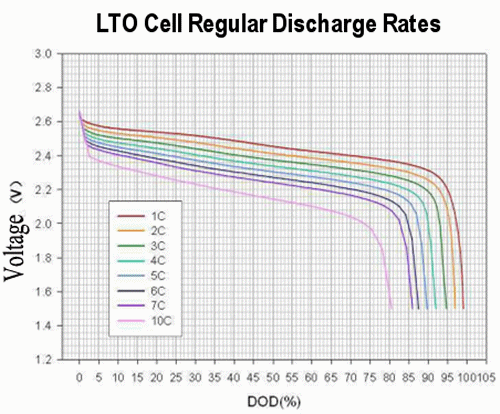Eric Hanson wrote:Brian,
Very interesting. These might make great batteries for an off grid system. Long life, lots of charge-discharge cycles and deep cycling are all highly important to an off grid application.
Don’t try to compare these with Lithium ion batteries though as these two battery technologies are really two different beasts. A lithium ion battery is extremely lightweight, very power/energy dense has a limited number of charge-discharge cycles and cannot be discharged past about 35% or it just dies. A lithium ion battery excels in lightweight, mobile applications. The lithium titanate batteries will shine in fixed applications that require lots of charges and deep discharges. While not great for a car, lithium titanate would be great for a house or cabin.
Very exciting topic, thanks for posting.
Eric
LTO batteries are lithium ion batteries. What you are referring to are likely lithium batteries that use Graphite as the anode. Those have high weight energy density (specific energy) at 260-300Wh/kg which makes them useful for portable devices. But they don't have high power density.
Lithium Titanate batteries have lower specific energy at 80-100Wh/kg. Weight is something that rarely matters in a stationary situation so they are good for that use case.
People in this thread have made the mistake of calculating cost per kWh which does not account for cycles where LTO excels at.
These are some calculations I made for batteries I found in a website that I don't have the links for.
Unknown: $900 / 1.024 kWh / 4000 cycles = ~0.22/kWh/cycle
Expensive EU warehoused A-grade LTO from Yinlong (without VAT): $90 / 0.103 kWh / 25000 cycles = ~0.035/kWh/cycle
LFP from Elerix: $4800 / 10.4 kWh / 6000 cycles = ~0.077/kWh/cycle
From the above, you can see that LTO comes out cheaper throughout it's life time when looking specifically at price, energy and cycles. And that's a price from a European seller for their grade-A cells. The grade-B cells are significantly cheaper at around $55 (before VAT) bringing the overall cost to ~0.021/kWh/cycle. You can get the price even lower if you find a good supplier from China.
There are other metrics that one might be interested in for a comparison like:
self-discharge ratedepth of discharge/usable capacitycharge and discharge efficiencyvolumetric density (if you don't have space)general lifespan regardless of cycles also known as shelf lifeoperating (for charge and discharge) and storage temperaturegeneral safety features (fire, overcharge, short-circuit, overheating, crush, penetration)etc.
You might care about recycling it too and the initial cost which is higher with LTO.
LTO excels at safety, it can be punctured and still function, unlike phone/laptop/electric car batteries.
It can be charged and discharged extremely fast (6C to 10C) which is called power density. Meaning that with a 100Wh battery, you can technically run a 1000W load for 6 minutes. Is this relevant for off grid storage? Maybe. I can think of a microwave or an oversized solar or other electricity generation source. For example, a 600W solar producing array can charge the before-mentioned battery in 10 minutes. Of course, it's recommended to charge and discharge slower as with all batteries to achieve the advertised lifespan but the possibility is there.
Wide range of operating and storing temperature from -45 to +65 celsius. That's relevant because you can keep them in an temperature unregulated room. Again, it's better to store them at room temperature.
And lastly, it doesn't require any ventilation unlike lead acid.
One less performing LTO battery from Elerix has published a datasheet of their tests. It's important to check those when buying a battery. They rate their 30Ah LTO battery for 16,000 cycles @ 1C/1C charge/discharge @ 25 celsius to reach 80% SOH (state of health or 80% of initial capacity). Similar to solar panels, it doesn't stop working after those cycles, just has less capacity. Increase the charge/discharge rates to shorten it's lifespan. Decreasing the rates will likely prolong the lifespan. Storing it at -20 celsius will likely shorten it. They also rate it at 30 years calendar life also called operating lifespan. The battery capacity is also rated at a certain charge/discharge time. This particular one is rated for 30Ah at 0.5C/0.5C. The real energy you get in and out will likely differ based on the rate you charge and discharge it at and other real life factors.
In my opinion, LTO and LFP are the superior choices when it comes to electric (there are non-electric ways to store energy) off grid storage.
There are more experimental options and their relative pros and cons that I've seen like zinc-bromite flow battery that has 100% usable capacity and can be left at 100% state of charge with no harm, has 36000+ cycles but only has 42Wh/kg or the salt water Aqueous Hybrid Ion battery that has no heavy metals, is non-explosive and non-flammable and reacts well to no usage over time but only has 3000 cycles at 70% depth of discharge and has operating temperature from -5 to +40. But those are not readily available as the rest are and their claims are not tested as much as the popular chemistries.






































 1
1
















 1
1







 1
1




 5
5








